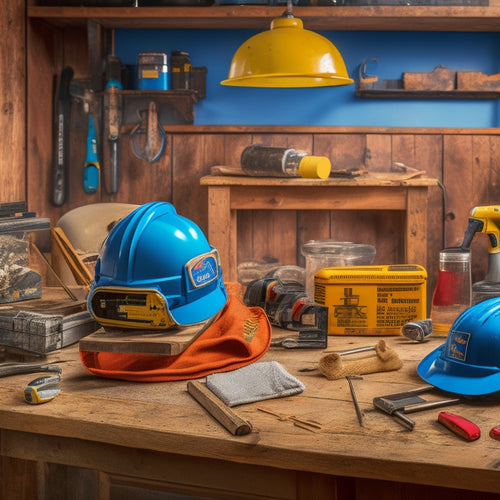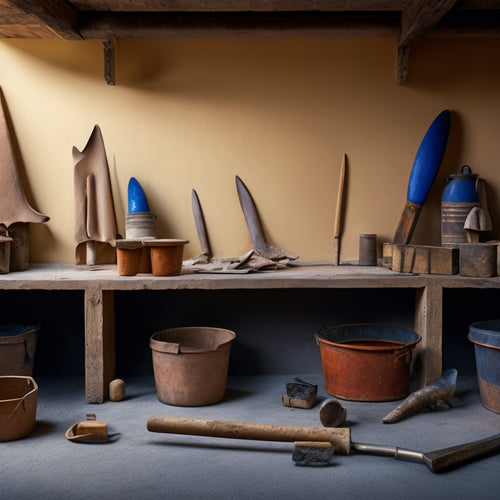
3 Best Safety Checklists for Home Renovation Beginners
Share
As a home renovation beginner, you'll want to guarantee a safe and successful project. Start by checking off essential safety gear, including a hard hat, safety goggles, dust mask, steel-toed boots, and protective clothing. Next, conduct a thorough walk-through to identify potential hazards like electrical, tripping, and structural risks. Finally, prepare your site by cleaning up, organizing your workspace, and implementing protective measures like drop cloths and waste disposal plans. By following these three vital safety checklists, you'll be well-prepared to tackle your renovation project with confidence, and a few more minutes of careful planning will help you avoid costly mistakes and guarantee a smooth journey ahead.
Key Takeaways
• Ensure you wear essential safety gear, including a hard hat, safety goggles, dust mask, steel-toed boots, and protective clothing.
• Conduct a thorough hazard identification walk-through to pinpoint potential electrical, tripping, and structural hazards in the workspace.
• Prepare the site by cleaning up debris, organizing tools and materials, and covering floors and surfaces with drop cloths.
• Establish a clear plan for waste disposal and ensure access to necessary amenities, such as water and restroom facilities.
• Document identified hazards and implement protective measures to maintain a safe environment throughout the renovation process.
Essential Safety Gear Checklist
You'll need to wear and use the following important safety gear to protect yourself from potential hazards on your home renovation site.
A hard hat is a must-have to prevent head injuries from falling objects or debris. It's imperative to choose a hard hat that fits snugly and has a chin strap to secure it in place.
Safety goggles are another critical piece of gear to shield your eyes from dust, debris, and chemical splashes. Look for goggles with anti-fog coating and good ventilation to prevent fogging.
Additionally, consider wearing a dust mask or respirator to filter out airborne particles and prevent respiratory problems.
Steel-toed boots or shoes with slip-resistant soles will help prevent foot injuries and slips.
Don't forget to wear long-sleeved shirts, long pants, and gloves to protect your skin from cuts, abrasions, and splinters.
Finally, make sure you have a first-aid kit on site, easily accessible in case of emergencies.
Hazard Identification and Control
Before starting your home renovation project, identify potential hazards in your workspace by conducting a thorough walk-through to pinpoint areas that could cause accidents or injuries. This hazard assessment is essential in preventing accidents and ensuring a safe working environment. As you walk through your space, take note of any potential risks, such as uneven flooring, exposed wiring, or heavy objects that could fall.
Some areas to focus on during your hazard assessment include:
-
Electrical hazards: Identify any exposed wiring, frayed cords, or overloaded outlets that could cause electrical shock or fires.
-
Tripping hazards: Look for uneven flooring, loose rugs, or cluttered walkways that could cause slips, trips, or falls.
-
Structural hazards: Check for any structural damage, such as weakened floors or walls, that could collapse or cause injury.
Pre-Renovation Site Preparation
With your hazard assessment complete, it's time to prepare your site for renovation by securing the area, protecting surrounding surfaces, and setting up necessary amenities to guarantee a smooth and safe working environment.
Before starting the renovation, you'll need to:
| Task | Description |
|---|---|
| Site Cleanup | Remove all debris, furniture, and personal items from the renovation area to prevent damage or injury. |
| Workspace Organization | Designate areas for tools, materials, and waste to maintain a clutter-free workspace and reduce tripping hazards. |
| Protective Measures | Cover floors, walls, and surfaces with drop cloths or plastic sheets to prevent damage from dust, debris, and spills. |
Frequently Asked Questions
Can I Renovate My Home Without Professional Supervision?
You're wondering if you can renovate your home without professional supervision. While it's possible, you'll need to take into account your budget and honestly assess your DIY skills.
If you're not confident in your abilities, hiring a pro can prevent costly mistakes and guarantee safety. Take an inventory of your skills and resources before deciding.
If you're unsure, it's better to err on the side of caution and seek professional guidance to avoid risks and potential harm.
How Do I Handle Unexpected Structural Damage Discoveries?
Imagine discovering a rotten beam while tearing down a wall, putting your entire renovation on hold. You've got to act fast!
When you uncover unexpected structural damage, don't panic. You'll need to call in a structural engineer for a thorough inspection to assess the extent of the damage.
Based on their report, prioritize emergency repairs to guarantee the site's safety. Then, reassess your renovation plan, adjusting timelines and budgets as needed.
Stay calm, and remember, safety always comes first.
Are There Any Specific Safety Regulations for DIY Projects?
When tackling a DIY project, you'll need to guarantee you're meeting safety standards and adhering to building codes.
Familiarize yourself with local regulations and obtain necessary permits. Conduct thorough risk assessments, and take steps to mitigate hazards.
Wear personal protective equipment, like hard hats and gloves, and maintain a clean workspace.
What Insurance Coverage Do I Need for Home Renovation Projects?
When tackling a home renovation project, you'll need to guarantee you have the right insurance coverage.
You should review your homeowner insurance policy to see if it covers renovation-related damages or accidents.
Additionally, consider liability coverage, which protects you in case a worker or visitor gets injured on your property.
Don't assume you're already covered - check your policy and consult with your insurer to get the necessary protection.
How Do I Dispose of Hazardous Waste Materials Safely?
As you hold the broken fluorescent light bulb, it's like grasping a ticking time bomb - hazardous waste that can't be tossed carelessly.
You're responsible for containing the threat. Proper disposal methods are key.
You'll need to identify local facilities that accept hazardous waste, then transport it in sealed containers.
Don't risk contaminating soil and water - take the time to do it right.
Research and plan, so you can safely dispose of hazardous materials and breathe easy.
Conclusion
You've made it to the final stage of your home renovation journey!
Remember, safety is key to a successful and stress-free project. According to the National Institute for Occupational Safety and Health, falls account for over 40% of fatal injuries in the construction industry.
By following these three essential safety checklists, you'll greatly reduce the risk of accidents and guarantee a smooth renovation process.
Stay vigilant, and you'll be enjoying your newly renovated home in no time!
Related Posts
-

Why Renovation Waste Disposal Harms the Environment
When you undertake a renovation project, you're contributing to a staggering problem: renovation waste disposal, whic...
-

Top 3 Safety Essentials for DIY Renovations
When tackling a DIY renovation, you'll want to prioritize three essential safety items to protect yourself from poten...
-

7 Best Plastering Bat Sizes for DIY Renovations
When tackling DIY renovations, you'll want to choose the right plastering bat size to achieve a professional-looking ...


